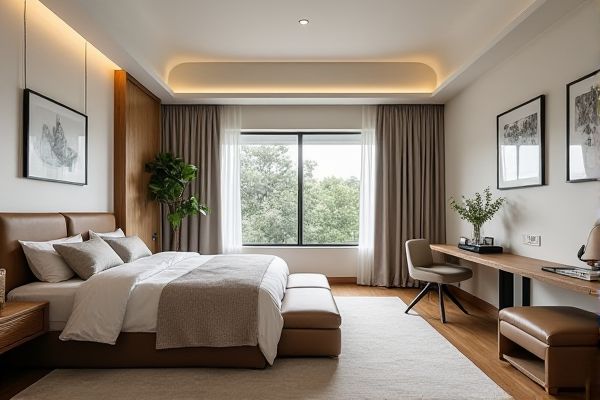
Choosing between a home office and a guest bedroom depends on your lifestyle and space needs, with a home office offering productivity and a guest bedroom providing comfort for visitors. Explore this article to help you decide which option best suits Your living space and priorities.
Table of Comparison
| Feature | Home Office | Guest Bedroom |
|---|---|---|
| Primary Use | Workspace for remote work, meetings, and productivity | Sleeping space for overnight visitors |
| Furniture | Desk, office chair, computer, storage units | Bed, nightstand, dresser, guest essentials |
| Space Requirements | Compact to medium-sized for equipment and comfort | Medium to large to accommodate bed and movement |
| Lighting | Bright, task-focused lighting, natural light preferred | Soft, ambient lighting for relaxation |
| Privacy | High priority for focused work and confidential calls | Moderate, ensures guest comfort and quiet |
| Storage Needs | Files, office supplies, technology devices | Bedding, guest clothes, luggage space |
| Additional Features | Internet connectivity, ergonomic setup | Comfortable bedding, welcoming decor |
| Flexibility | Can be converted to a multi-use space (e.g., study) | Primarily dedicated to guests, may double as storage |
Home Office vs Guest Bedroom: Key Differences
A home office prioritizes productivity and ergonomic furniture, equipped with desks, office chairs, and technology to support remote work. A guest bedroom emphasizes comfort and hospitality, featuring beds, nightstands, and storage tailored for temporary stays. Spatial layout and design choices reflect their distinct functions, with home offices often requiring reliable lighting and connectivity, while guest bedrooms focus on coziness and privacy.
Space Utilization: Productivity vs Hospitality
Maximizing space utilization in your home requires balancing productivity and hospitality, where a dedicated home office fosters focus and efficiency through ergonomic design and organized storage. In contrast, a guest bedroom prioritizes comfort and welcoming amenities, optimizing the space for relaxation and overnight stays. Choosing between these options depends on whether your primary goal is to enhance work performance or accommodate visitors, ensuring the room serves its most valuable purpose based on your lifestyle.
Design and Decor Considerations
Maximizing your home's functionality requires carefully balancing design and decor when choosing between a home office and a guest bedroom. A home office benefits from ergonomic furniture, ample lighting, and organized storage solutions to boost productivity, while a guest bedroom prioritizes comfort with cozy bedding, inviting color schemes, and thoughtful amenities. Selecting versatile furniture like foldable desks or daybeds can enhance the dual-purpose appeal, ensuring your space meets both professional and hospitality needs without sacrificing style.
Essential Furniture and Storage Solutions
A functional home office requires an ergonomic desk, a comfortable chair with lumbar support, and reliable storage options such as filing cabinets or shelving units to organize documents and office supplies. In contrast, a guest bedroom prioritizes a comfortable bed, bedside tables with lamps, and versatile storage like dressers or closets to accommodate visitors' belongings. Both spaces benefit from multi-functional furniture, such as desks with built-in drawers or beds with under-storage, to maximize usability and maintain a clutter-free environment.
Balancing Comfort for Work and Guests
Creating a multifunctional space that serves as both a home office and a guest bedroom requires carefully selecting ergonomic furniture that provides comfort during work hours and restful sleep for guests. Incorporating a fold-out sofa bed or a murphy bed with high-quality mattress options ensures an easy transition between work and relaxation. Optimal lighting and storage solutions help maintain organization and ambiance, enhancing productivity and hospitality in the shared room.
Privacy and Noise Management
A dedicated home office offers enhanced privacy and noise management by providing a separate, controlled environment ideal for focused work and confidential meetings. Guest bedrooms often lack this level of sound insulation and may be subject to household distractions, reducing productivity and concentration. Optimizing acoustic treatments and strategic room placement improves noise isolation in home offices, ensuring a quiet workspace distinct from guest living areas.
Technology Requirements for a Home Office
A home office demands advanced technology requirements such as a high-speed internet connection, ergonomic computer setup, and reliable video conferencing tools to support productivity and seamless communication. Unlike a guest bedroom, which prioritizes comfort and minimal tech needs, your home office must include multiple power outlets, cable management solutions, and noise-canceling devices to create an efficient work environment. Proper technology integration enhances workflow and reduces distractions, making the space functional and conducive to professional tasks.
Guest Bedroom Amenities and Comfort
A guest bedroom should include essential amenities such as a comfortable mattress, quality bedding, and adequate storage space to enhance the guest experience. Additional touches like bedside lamps, charging stations, and blackout curtains contribute significantly to comfort and convenience. Providing a welcoming atmosphere with fresh linens, extra pillows, and accessible climate control ensures guests feel at home during their stay.
Cost and Budget Considerations
Converting a guest bedroom into a home office typically requires investing in ergonomic furniture, technology, and adequate lighting, which can significantly impact the budget. Guest bedrooms often involve fewer immediate expenses, primarily limited to comfortable bedding and minimal decor. Home offices offer long-term productivity benefits that may justify the initial higher costs compared to the occasional use and lower maintenance expenses of guest bedrooms.
Tips for Creating a Multi-Functional Space
Maximize your space by selecting furniture that serves dual purposes, such as a sleeper sofa or a desk with built-in storage. Use room dividers or shelving units to visually separate work and relaxation zones, enhancing productivity and comfort. Incorporate adjustable lighting and ergonomic seating to support both office tasks and guest needs effectively.
 homyna.com
homyna.com